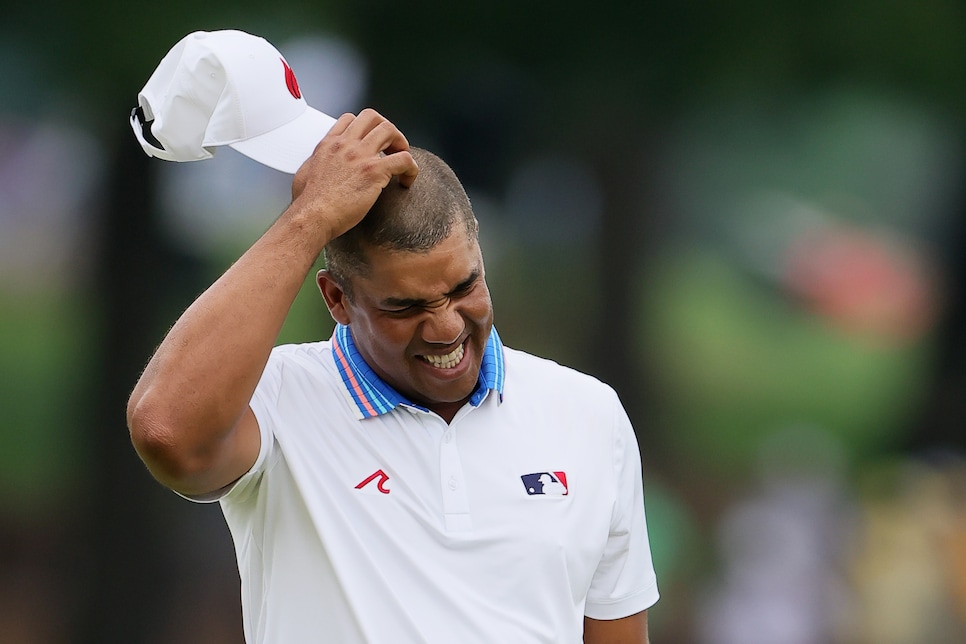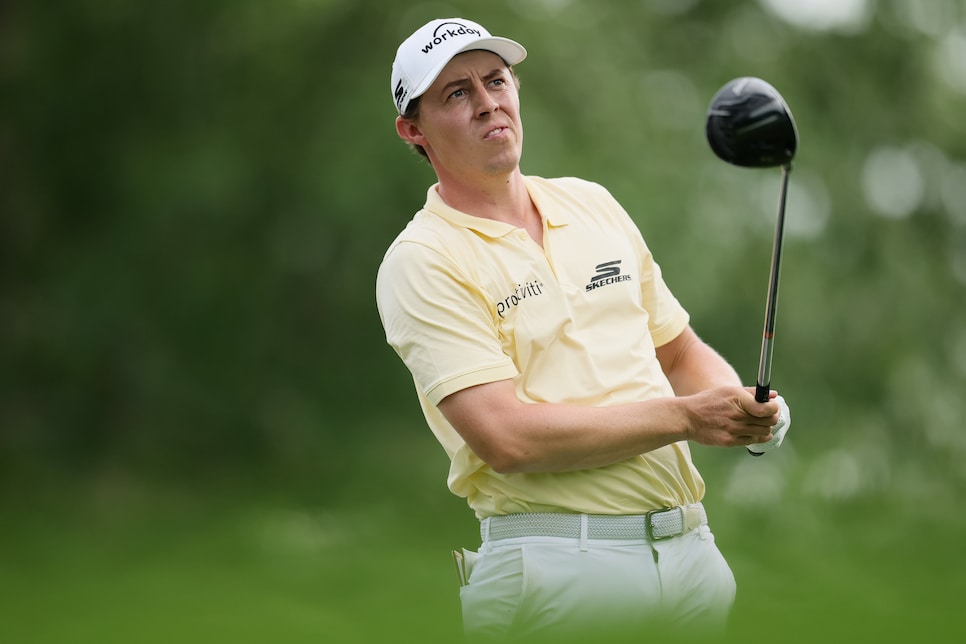CHARLOTTE — There’s something brewing here at Quail Hollow. We sense it, but can’t quite define it—is it good, bad, excitement, nervousness, outrage, or indifference? It’s too early to tell with this PGA Championship only halfway home. The crowds feel it too, carrying a frenetic energy they haven’t yet channeled in any particular direction. So as you survey the events unfolding over these first two days, what do you think is happening?
Let’s examine the leaderboard. History suggests our champion is likely among the current top 10, as 13 of the last 14 PGA Championship winners held that position after 36 holes (Collin Morikawa the lone exception in 2020). That narrows our focus to: Jhonattan Vegas leading at eight under; Matthieu Pavon, Matt Fitzpatrick, and Si Woo Kim at six; Max Homa and Scottie Scheffler at five; with another 10 players, including Robert MacIntyre and J.T. Poston, at four. Scheffler’s name stands out and deservedly so. The World No. 1 has contended in six of his last eight major starts, including last May’s bizarre episode at Valhalla where he was inexplicably arrested while entering the parking lot. Fitzpatrick brings major championship pedigree, finally awakening from a season-long slumber, while Homa has made Quail Hollow his personal sanctuary, capturing his breakthrough win here in 2019 and going undefeated (4-0) during the 2022 Presidents Cup. Bryson DeChambeau lurks five shots back, close enough to keep his devoted followers invested. The leaderboard showcases international diversity with 11 different countries represented among the top 17 players.
However—in candid assessment—this leaderboard is remarkably eclectic. Si Woo Kim hasn’t recorded a top-10 finish in 31 major appearances. Ryan Fox and Alex Smalley were contending at an alternate event just last week. Pavon showed promise at last year’s U.S. Open but has accomplished little since. Vegas, despite four career victories and a respectable tour résumé, has made just one major cut in seven years. Ryan Gerard, Christiaan Bezuidenhout and Sam Stevens are undeniably talented players, yet hardly names you’d expect atop a major championship leaderboard. Thanks to Scheffler, Fitzpatrick and Homa, Friday’s leaderboard carries marginally more star power than Thursday’s—though that’s only because any star power surpasses none at all.
Let’s pivot to the absences from our leaderboard. Rory McIlroy seemed predestined for weekend contention—with four victories at Quail Hollow and entering Charlotte unburdened by expectations after his Masters triumph. Instead, a non-conforming driver derailed him and his replacement club failed him miserably, finding just 10 fairways through two rounds. While he survived the cut, it was merely on the number, leaving him nine shots adrift and anchoring the bottom of the leaderboard heading into Saturday.

Alex Slitz
If McIlroy seeks consolation, he might find it in the company he keeps. Six of the world’s top 10 players were unceremoniously dismissed, including Justin Thomas and Ludvig Aberg. Coming into the PGA, five players—Hideki Matsuyama, Xander Schauffele, Patrick Cantlay, Patrick Reed and Scheffler—had maintained streaks of at least 11 consecutive made cuts in majors. Matsuyama, Cantlay, and Reed suffered emphatic ejections, while Schauffele required a desperate back-nine rally Friday just to survive on the number. Jordan Spieth’s career Grand Slam pursuit must wait until next May in Philadelphia after missing the cut by a single stroke. Masters runner-up Justin Rose is gone. Brooks Koepka’s presence earlier in the week remains merely rumored; Dustin Johnson outperformed exactly one tour professional.
Individually, each disappointment carries a reasonable explanation. Even the elite experience bad weeks with unfortunate breaks, uncooperative swings, and putts that encounter invisible “road closed” signs. However, when this many stars crash out while so many journeymen crowd the leaderboard, deeper examination becomes necessary.
In the most charitable interpretation, we’re witnessing meritocracy in action. The principle that every stroke matters, positions aren’t granted but earned, and only the number beside your name determines your fate—this remains golf’s fundamental ethos. It’s precisely why romantics and traditionalists rail against LIV Golf’s comfortable confines and the tour’s signature events with their limited fields and absent cuts. Logically, they should celebrate this leaderboard, shouldn’t they?
Yet golf harbors an aversion to Cinderellas. Our competitive universe orbits around its stars, drawing power from their gravitational pull. Without compelling backstories or magnetic personalities, the sport prefers its prestigious championships claimed by its marquee attractions. With all due respect to most contenders currently populating the leaderboard, they haven’t yet achieved attraction status. Regarding those full fields and cuts—there’s another perspective to consider. This universe grows exceedingly dark when its luminaries fade, and shadows could lengthen rapidly should Scheffler falter on Saturday.

Alex Slitz
Which leads us to reconsider Quail Hollow as a major championship venue. It’s not inadequate—it’s visually appealing, immaculately maintained, expansive enough for tournament officials to accommodate spectators, corporate hospitality, and generate substantial revenue. It’s serviceable—but “serviceable” falls short, particularly for courses as predictable and one-dimensional as this one. Pre-tournament narratives fixated on McIlroy, Scheffler and DeChambeau, understandably so, but this focus disregarded Quail’s history as a regular tour stop that consistently produces unlikely champions like Homa, Derek Ernst, Anthony Kim and Joey Sindelar. Consider the 2017 PGA Championship here, which featured Thorbjorn Olesen, D.A. Points, Chris Stroud, Bud Cauley and Jim Herman among its final Sunday groupings. What we’ve witnessed through 36 holes merely extends the reality Quail Hollow has always manifested. If golf truly rejects the notion of unheralded players claiming its prestigious events, one must question what, precisely, the sport expected to happen.
Bringing us to atmosphere—undeniably one of Quail Hollow’s triumphs this week. The environment exudes the feel of a big-time event. The galleries hunger for fireworks, yet so far, they’ve been served sparklers instead of Roman candles, creating a peculiar tension of anticipation. Perhaps the weekend’s arrival will transform this energy. After the transcendent drama we witnessed at Augusta, however, these opening rounds have felt like the inevitable morning-after malaise.
Conversely, we’ve completed only half the prescribed journey, and tournaments of this magnitude reveal their character across all 72 holes. Something extraordinary may still be fermenting beneath the surface. Perhaps. We remain gloriously uncertain. Therein lies both the allure and anxiety of this major championship.
This article was originally published on golfdigest.com

